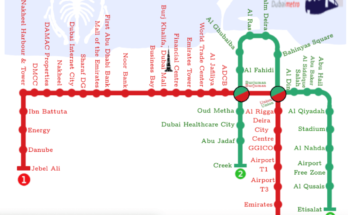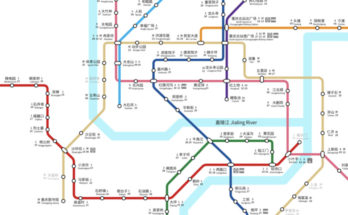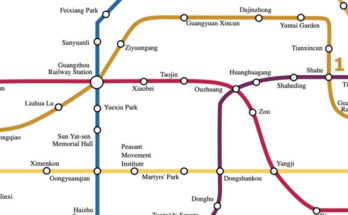Although the Delhi Metro is not the first in India it can be said it is the first of its kind in the country. The metro railway network has almost covered the entire city and follows with continuous endeavors of expansion. Most of the neighboring areas and suburbs will be covered by the metro railway by the end of 2020.This rapid transit system serves Delhi, Gurgaon, Noida, and Ghaziabad and carries over 1.8 million passengers every day.
The Delhi Metro network consists of six lines with a total length of 193 kilometres with 145 stations (35 are underground, five are at-grade, and the remainder are elevated). Delhi Metro is being built and operated by the Delhi Metro Rail Corporation Limited (DMRC) and is owned by the State along with the Government of the territorial capital of Delhi. The organisation is under administrative control of Ministry of Urban Development, Government of India. Construction started in 1998, and the first section, on the Red Line opened in 2002, followed by the Yellow Line in 2004, the Blue Line in 2005, its branch line in 2009, the Green and Violet Lines in 2010, and the Delhi Airport Metro Express in 2011.
Delhi Metro Lines
The Delhi Metro network consists of 6 lines with a total length of 193 kilometres with 145 stations, but this figures change rapidly.
- Red Line: Dilshad Garden – Rithala. It runs from Dilshad Garden to Rithala, with a lenght of 25.1 Kms and 21 stations on this route. At present, the line is fully operational.
The red line has two interchange stations, the first at Kashmere Gate with the yellow line and the second Inderlok with the green line. - Yellow Line: Jahangirpuri – HUDA city centre (in neighbouring Gurgaon) covers a distance of 45 kms and there are 34 stations on this route. In this line we find the country’s deepest metro station at Chawri Bazaar, situated 30 metres below ground level.
- Blue Line: Dwarka Sector- Noida City Centre (in neighbouring Noida) The Blue Line was the third line of the metro to be opened, and the first to connect areas outside Delhi.Consists of 50 stations from Dwarka Sector 21 to Noida City Centre (sector 32) with a length of 56.5 km including the branch to Vaishali starting in Yamuna Bank Station of 6.25 kms. This line crosses the Yamuna River between Indraprastha and Yamuna Bank stations. Karkardooma station on Vaishali branch is the highest station of Delhi Metro with a platform height of 19 meters.
- Green Line: Inderlok – Mundka – Ashok Park Main. It is the first Delhi Metro line that offers the standard-gauge corridor. The total distance covered on this fully elevated line is approximately 19 km including a branch to Kirti Nagar with 18 stations.
- Violet Line:- Central Secretariat – Badarpur. It began operations in October 2010. The route covers a total distance of 20 km that includes 16 important stations.
- Airport Express – Dwarka Sector 21. It links with Indira Gandhi Airport. The line, also known as the Orange line is operated by the Delhi Airport Metro Express Pvt. Limited (DAMEL). The total length of the line is 22.7 km, of which 15.7km is underground.The trains travel at up to 135km/h, instead of up to 80km/h as on the rest of the metro.
Future expansions:
The Delhi Metro is being constructed in phases. Phases I-II are now ready. Phases III (105km) and IV (108.5km) are planned to be completed by 2015 and 2021 respectively, with the network spanning 413km by then.
Phase III: The plans are to cover Yamuna Vihar-Mukundpur corridor, which will be the longest line in the Delhi Metro network that will cover around 55.9 kms. The major stations on this route will be Mukundpur, Rajouri Garden, Dhaula Kaun, Anand Vihar and culminate at Yamuna Vihar. It will also give coverage of the Jamia Milia University.The significant thing about the Phase III metro is that it will have 23 interchangeable stations for seamless connectivity.
The Delhi Metro Phase III along with I and II phase can cover almost 70 percent of Delhi.
Metro Opening Hours
The subway schedule is from 06:00 a.m till about 23:00 p.m in the night.
Frequency Step
The train frequency varies depending on the line ranging from 3 minutes at peak time up to 13 minutes in non peak hours.
For more info: http://www.delhimetrorail.com/metro_timing.aspx
Fares and Tickets
Delhi Metro commuters have three choices for ticket purchase:
- Tokens, wich are valid only for a single journey on the day of purchase and the value depends on the distance travelled, with fares for a single journey ranging from INR 8 (€0.11) to INR 30 (€0.40).
- Rechargeable Travel Cards are available for longer stays and are most convenient for frequent commuters. They are valid for one year from the date of purchase or the date of last recharge, and are available in denominations of INR 100 (€1.38) to INR 800 (€11). A 10% discount is given on all travel made on it.
- The Tourist Cards valid for one and three days of unlimited travelling respectively. The cost of a one-day card is INR100 (€1.35) and for a three-day card is INR 250 (€3.45), besides a refundable deposit of INR 50 (€0.70) that must be paid at the time of purchasing the card.
Airport
Delhi Airport Metro Express Line links the Indira Gandhi International Airport, located 16 kilometres south west of New Delhi city centre.
It was initially planned to run trains 24 hours a day with a frequency of 10 minutes, but currently train services operate from 05:15 am to 11:14 pm, with a 13 minute frequency. The travel time from New Delhi railway station to the Airport T3 is 18 mins. The fare for this trip has been fixed at INR 80 (€1.12).



